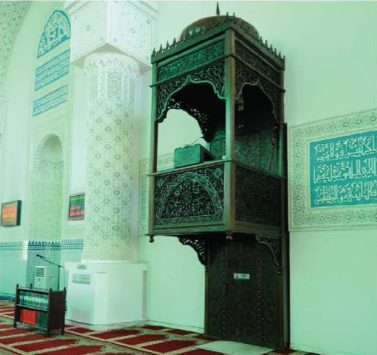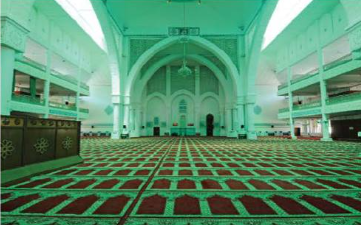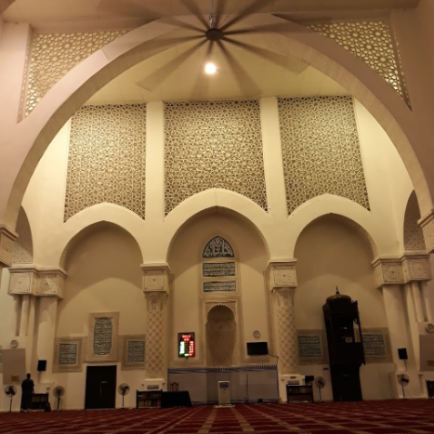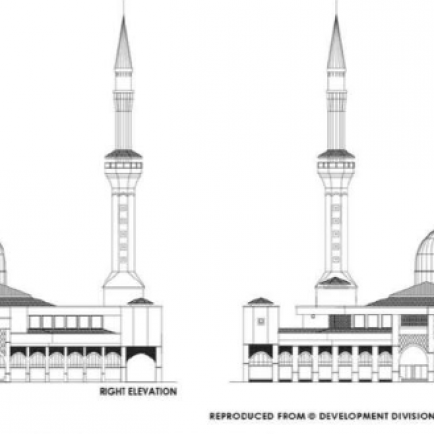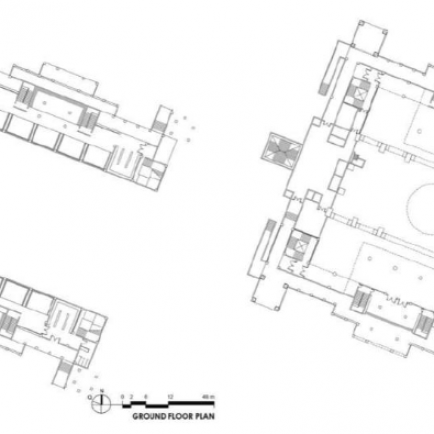Sultan Haji Ahmad Shah Mosque
History
Completed in 1997, it was officiated by Sultan Haji Ahmad Shah, the Sultan of Pahang in 2000. The mosque was named in honour of His Majesty as the Constitutional Head of the University. Built over four levels, the mosque can accommodate up to 9,000 worshippers at any time. The university has also become one of the most renowned Islamic universities in the world.
Urban and Architectural
Nestled around academic and administrative blocks, the mosque is strategically linked with various central facilities, library and classrooms through corridor walkways and inner courtyards. Thus, the mosque’s building and its compounds have multi-entrances including the qibla wall side that links to the mosque’s porch and an open plaza.
Clad in blue glazed tiles and brownish concrete spray finish, its elevations are overshadowed by the surrounding buildings. However, the Nabawi-inspired hemispherical blue dome and Ottoman-inspired twin-pointed slender minarets has become the distinctive landmark of this mosque. From a distance, the mosque’s position is easily recognisable by these features.
An outdoor ablution area is located in front of the mosque
from the east entrance, built in a pavilion-type structure with a dome similar
1e the shape of the main dome, A walkway corridor surrounds the main prayer hall,
and it also acts as an overspill prayer area. The pointed arches of the walkway
are partially shaded with colored stained glass and geometrical pattern frame grilles.
Inside the main prayer hall, the main dome sits on the
modern interpretation of a squinch, with six main piers, which form huge arches.
The upper prayer galleries are distributed on each side, except the qibla wall.
Maximizing the courtyard open space, the architect had attempted to promote the
use of cross ventilation across the main prayer hall through the introduction
of large openings with less walls which can prevent the natural flow of the
wind.
A large chandelier hangs from the main dome, with two
recently installed big S' fans installed in the front and rear of the main prayer
hall. Formed by three pointed arches, the mihrab niche is placed at the center
with detailed plaster carvings and a wooden mimbar platform on the far right,
reminiscent of the Malay vernacular design.
Description
The Sultan Haji Ahmad Shah Mosque is an example of how a university mosque has been planned and placed in an Islamic campus design. It is in the heart of the main campus of the International Islamic University Malaysia (IIUM) in Gombak, Selangor. As one of the first Islamic Universities in the country, the mosque is a part of the university ethos as a comprehensive learning centre for Islamic and worldly studies and is considered inseparable from each other.
References
https://itc.gov.my/listings/masjid-sultan-haji-ahmad-shah-iium/
https://taaruf.iium.edu.my/wp-content/uploads/2020/09/Copy-of-Masjid-Profile-2020.pdf
Aziz, A. A., 2016. MASJID - Selected Mosques and Musollas in Malaysia, ATSA Architects Sdn. Bhd.
Details
Location
International Islamic University Malaysia, Jalan Gombak, 53100 Kuala Lumpur, Selangor, Malaysia
Worshippers
9000
Owners
the Sultan of Pahang
Architect Name
Year of Build
1997
Area
8520
Drawings
Map
History
Completed in 1997, it was officiated by Sultan Haji Ahmad Shah, the Sultan of Pahang in 2000. The mosque was named in honour of His Majesty as the Constitutional Head of the University. Built over four levels, the mosque can accommodate up to 9,000 worshippers at any time. The university has also become one of the most renowned Islamic universities in the world.
Urban and Architectural
Nestled around academic and administrative blocks, the mosque is strategically linked with various central facilities, library and classrooms through corridor walkways and inner courtyards. Thus, the mosque’s building and its compounds have multi-entrances including the qibla wall side that links to the mosque’s porch and an open plaza.
Clad in blue glazed tiles and brownish concrete spray finish, its elevations are overshadowed by the surrounding buildings. However, the Nabawi-inspired hemispherical blue dome and Ottoman-inspired twin-pointed slender minarets has become the distinctive landmark of this mosque. From a distance, the mosque’s position is easily recognisable by these features.
An outdoor ablution area is located in front of the mosque
from the east entrance, built in a pavilion-type structure with a dome similar
1e the shape of the main dome, A walkway corridor surrounds the main prayer hall,
and it also acts as an overspill prayer area. The pointed arches of the walkway
are partially shaded with colored stained glass and geometrical pattern frame grilles.
Inside the main prayer hall, the main dome sits on the
modern interpretation of a squinch, with six main piers, which form huge arches.
The upper prayer galleries are distributed on each side, except the qibla wall.
Maximizing the courtyard open space, the architect had attempted to promote the
use of cross ventilation across the main prayer hall through the introduction
of large openings with less walls which can prevent the natural flow of the
wind.
A large chandelier hangs from the main dome, with two
recently installed big S' fans installed in the front and rear of the main prayer
hall. Formed by three pointed arches, the mihrab niche is placed at the center
with detailed plaster carvings and a wooden mimbar platform on the far right,
reminiscent of the Malay vernacular design.
Description
The Sultan Haji Ahmad Shah Mosque is an example of how a university mosque has been planned and placed in an Islamic campus design. It is in the heart of the main campus of the International Islamic University Malaysia (IIUM) in Gombak, Selangor. As one of the first Islamic Universities in the country, the mosque is a part of the university ethos as a comprehensive learning centre for Islamic and worldly studies and is considered inseparable from each other.






